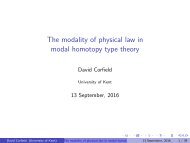TOMBO Ver.2 Manual
TOMBO
TOMBO
You also want an ePaper? Increase the reach of your titles
YUMPU automatically turns print PDFs into web optimized ePapers that Google loves.
1.2 Mixed basis formulation 2<br />
to these methods is a basis set superposition error (BSSE) [6, 7]. There is also some trouble<br />
in the Gaussian basis method [8] to describe cusp in the wave-funcion at the nuclear position.<br />
In these respects, it is highly desirable to develop new method, which combines the<br />
PW expansion technique with the LCAO technique to remove pseudopotentials in the PW<br />
expansion methods and to make the basis set complete in the LCAO methods. This is the<br />
main idea to introduce the all-electron mixed basis approach. <strong>TOMBO</strong> [1, 2] is the program<br />
package using this approach. <strong>TOMBO</strong> is the all-electron first-principles method, which can<br />
be applicable to both isolated and periodic systems with complete basis set. It is not the<br />
overcomplete basis set because only limited number of PWs is used in the computation.<br />
The powerfulness of <strong>TOMBO</strong> is not only based on these features but also based on the<br />
fact that it enables us to perform the state-of-the-art calculations such as GW approximation<br />
and Bether–Salpeter equation (BSE). Using these methods, <strong>TOMBO</strong> can treat the problems<br />
related to electron correlations, electronic structure around the band gap, excitation spectra,<br />
and so forth. This <strong>TOMBO</strong> <strong>Ver.2</strong> is a new version made by unifying preexiting several<br />
versions: Molecular dynamics code [9], crystal code [10], T -matrix and GW + BSE code<br />
[11], and <strong>TOMBO</strong> Ver.1 [12].<br />
1.2 Mixed basis formulation<br />
The “mixed-basis” indicates the method using both plane waves and Bloch sums made<br />
of atomic orbitals as the basis set.<br />
For an isolated atom, it is possible to solves the Kohn–Sham equation very rigorously,<br />
because of the system has a spherical symmetry. In this case, the Kohn-Sham wave function<br />
is expressed as a product of radial function R jnl (r) and spherical harmonics Y lm (r) as<br />
ϕ AO<br />
jnlm (r) = R jnl(r)Y lm (ˆr) (1.1)<br />
Here, j, n, l, and m are atomic species, principal quantum number, angular momentum<br />
quantum number, and magnetic quantum number.<br />
In the mixed basis code, the KS wave function is expressed as a linear combination of<br />
PWs and AOs (Fig. 1.1),<br />
ψ v (r) = √ 1<br />
Ω<br />
∑<br />
c PW<br />
G<br />
v (G)e i(k+G)·r +∑<br />
j<br />
∑<br />
nlm<br />
c AO<br />
v<br />
( jnlm)ϕ Bloch (k,r) (1.2)<br />
jnlm<br />
with<br />
ϕ Bloch<br />
jnlm (k,r) = eik·R j<br />
∑<br />
R<br />
e ik·R ϕ AO<br />
jnlm (r − R j − R). (1.3)



